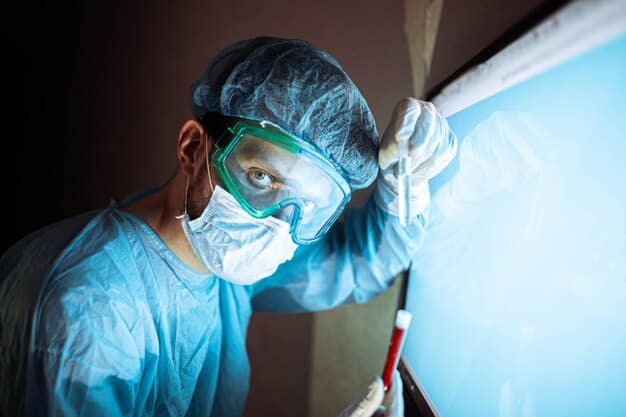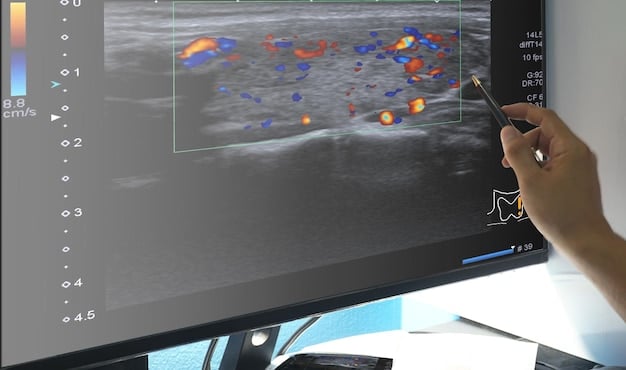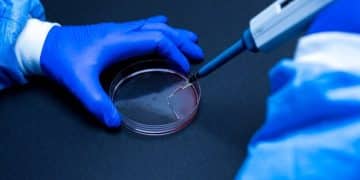Vasectomy Reversal: Success Rates, Costs & 2025 Expectations

Vasectomy reversal is a surgical procedure to restore fertility after a vasectomy, with success rates influenced by factors like the time since the vasectomy; in 2025, advancements in microsurgical techniques continue to refine outcomes, but costs can vary widely, making comprehensive consultations essential for informed decision-making.
Considering a vasectomy reversal: success rates, costs, and what to expect in 2025 can be a lot to think about, but with the right information, you can make an informed decision about your future fertility options.
Understanding Vasectomy Reversal
Vasectomy reversal is a microsurgical procedure designed to restore fertility in men who have previously undergone a vasectomy. It involves reconnecting the vas deferens, the tubes cut during a vasectomy, to allow sperm to flow normally again.
For many men, the decision to undergo a vasectomy reversal is driven by changes in life circumstances, such as remarriage or a desire to have more children. Understanding the procedure is the first step in exploring this option.
Microsurgical Techniques
The precision required for a vasectomy reversal often involves microsurgical techniques. These techniques utilize high-powered microscopes and specialized instruments to enhance the surgeon’s ability to reconnect the vas deferens accurately.
Types of Reversal Procedures
- Vasovasostomy: This involves directly reconnecting the two ends of the vas deferens. It is typically performed when there is no blockage or scarring.
- Vasoepididymostomy: This more complex procedure is needed when there is a blockage in the epididymis. It involves connecting the vas deferens to the epididymis, bypassing the blockage.
Choosing the right type of reversal procedure depends on the individual’s specific anatomy and condition. A thorough evaluation by a qualified surgeon is essential to determine the best approach.
In summary, understanding the nuances of vasectomy reversal, including the surgical techniques and types of procedures, is crucial for setting realistic expectations and ensuring the best possible outcome.

Success Rates of Vasectomy Reversal
Success rates for vasectomy reversal are a primary concern for men considering this procedure. A variety of factors can influence the likelihood of achieving a successful outcome, including the time since the original vasectomy.
Generally, the sooner a reversal is performed after a vasectomy, the higher the chances of success. However, advancements in surgical techniques have improved outcomes even for those who had a vasectomy many years ago.
Factors Affecting Success
Several factors play a significant role in the success of a vasectomy reversal. These include the surgeon’s experience, the techniques used, and the presence of any complicating factors.
Realistic Expectations
- Patency Rate: Refers to the percentage of men who have sperm present in their ejaculate after the reversal.
- Pregnancy Rate: Represents the percentage of couples who achieve pregnancy after the reversal.
- Time Since Vasectomy: Longer intervals typically correlate with lower success rates.
Understanding these factors and setting realistic expectations are essential for a positive experience with vasectomy reversal.
In conclusion, success rates in vasectomy reversal are multifaceted, hinging on both the surgeon’s expertise and individual health factors. With a clear understanding of these dynamics, patients can approach the procedure with well-informed expectations.
What to Expect in 2025
Looking ahead to 2025, several trends and advancements are expected to influence the landscape of vasectomy reversal. These include refinements in surgical techniques and a greater emphasis on personalized patient care.
Additionally, ongoing research may lead to new methods for assessing fertility potential and improving outcomes. Keeping abreast of these developments can help men make informed decisions about their reproductive health.
Advancements in Techniques
Microsurgical techniques continue to evolve, offering even greater precision and improved outcomes. These advancements include the use of robotic-assisted surgery and enhanced imaging technologies.
Future Fertility Outlook
Several developments could shape the future of fertility after vasectomy reversal. These include:
- More sophisticated diagnostic tools to evaluate sperm quality and function.
- Improved methods for preserving sperm for future use.
- Greater availability of telemedicine consultations for remote monitoring and support.
By staying informed about these trends, men can better prepare for the possibilities and challenges of restoring fertility.
In short, the field of vasectomy reversal in 2025 is poised to benefit from ongoing technological advancements and a growing emphasis on individualized patient care, promising even better outcomes for those seeking to restore their fertility.

The Costs Associated with Vasectomy Reversal
The costs associated with vasectomy reversal can be a significant consideration for many men. Understanding the various expenses involved is crucial for financial planning and decision-making.
The total cost can vary widely depending on factors such as the type of procedure, the surgeon’s fees, and the location of the clinic or hospital. It’s essential to obtain a detailed estimate before proceeding.
Typical Expenses
Several expenses are typically involved in vasectomy reversal. These include:
- Surgeon’s fees
- Anesthesia costs
- Facility fees
Minimizing Costs
While the cost of vasectomy reversal can be substantial, there are ways to potentially minimize expenses. These include:
- Seeking out-of-network providers.
- Inquiring about financing options or payment plans.
- Verifying insurance coverage and understanding any out-of-pocket costs.
Careful planning and research can help manage the financial aspects of this procedure.
In essence, understanding and planning for the costs associated with vasectomy reversal is crucial for making an informed decision. By exploring all available options, you can ensure that financial considerations align with your overall goals.
Finding the Right Surgeon
Finding the right surgeon for a vasectomy reversal is a critical step in ensuring a successful outcome. The surgeon’s experience, qualifications, and approach to patient care can all influence the overall experience and results.
Men considering this procedure should take the time to research and evaluate potential surgeons. This may involve reviewing their credentials, reading patient testimonials, and scheduling consultations.
Questions to Ask
When meeting with potential surgeons, it is essential to ask pertinent questions. Consider asking about:
- The surgeon’s experience with vasectomy reversals.
- The types of techniques they use.
- Their success rates.
Considerations for Choosing
In addition to qualifications and experience, consider the surgeon’s communication style and approach to patient care. Look for someone who:
- Listens to your concerns and answers your questions thoroughly.
- Provides clear and realistic expectations.
Making an informed decision about your surgeon can contribute significantly to your comfort and confidence throughout the process.
In conclusion, thoughtfully selecting the right surgeon is a pivotal step in the vasectomy reversal journey, requiring diligent research and open communication to ensure the best possible outcome.
Preparing for the Procedure
Proper preparation is essential for a smooth and successful vasectomy reversal. This involves both physical and mental preparation to ensure that you are ready for the procedure and recovery.
Your healthcare provider will provide specific instructions tailored to your individual needs. However, some general guidelines can help you prepare effectively.
Physical Preparation
Physical preparation for a vasectomy reversal may include:
- Undergoing a thorough medical evaluation.
- Following dietary recommendations.
Setting Yourself Up for Success
Mental preparation is equally important. Consider:
- Discussing your concerns and expectations with your surgeon.
- Enlisting the support of family and friends.
By taking these steps, you can help ensure a positive and rewarding experience.
In summary, diligent preparation, both physically and mentally, sets the stage for a successful vasectomy reversal, empowering you to approach the procedure with confidence and peace of mind.
| Key Aspect | Brief Description |
|---|---|
| 👨⚕️ Surgical Techniques | Microsurgery enhances precision, improving reconnection success. |
| 📈 Success Rates | Influenced by time since vasectomy and surgeon’s expertise. |
| 💰 Costs | Vary widely; consider surgeon fees, anesthesia, and facility costs. |
| 🗓️ 2025 Expectations | Advancements in techniques & personalized care improve outcomes. |
Frequently Asked Questions
▼
The sooner you undergo the reversal after the vasectomy, the higher the chances of success, though advancements have improved outcomes even years later.
▼
The procedure typically takes between 2 to 4 hours, depending on the complexity and the technique used by the surgeon.
▼
Recovery usually takes 1 to 2 weeks. During this time, it is crucial to avoid strenuous activities and follow the surgeon’s instructions.
▼
Coverage varies widely by insurance provider. Contact your insurance company to understand your specific plan’s coverage for the procedure.
▼
Risks include infection, bleeding, chronic testicular pain, and failure of the reversal, although these complications are rare with an experienced surgeon.
Conclusion
In conclusion, understanding the complexities surrounding vasectomy reversal: success rates, costs, and what to expect in 2025 empowers individuals to make informed decisions aligned with their reproductive goals, ensuring a thoughtful approach to restoring fertility.





